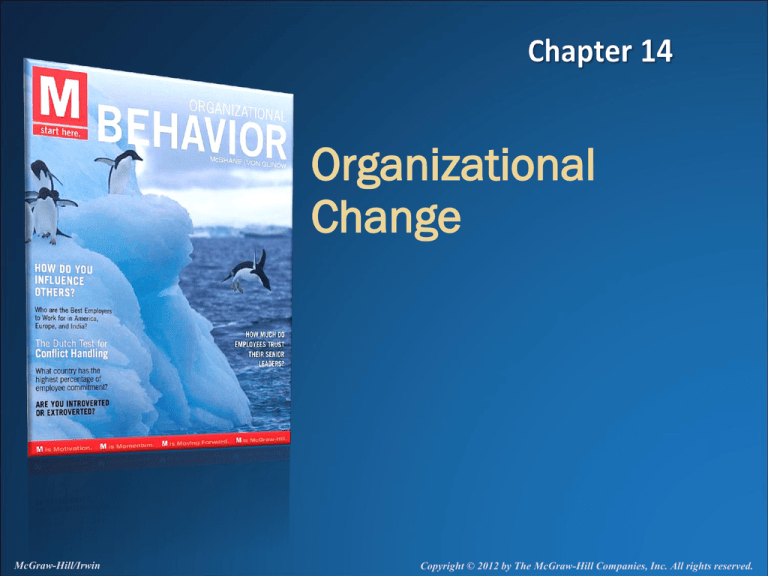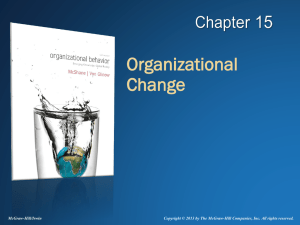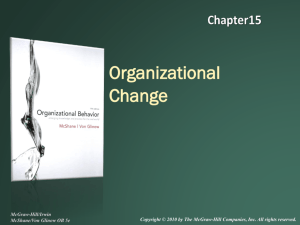
Organizational
Change
McGraw-Hill/Irwin
Copyright © 2012 by The McGraw-Hill Companies, Inc. All rights reserved.
Lewin’s Force Field Analysis Model
Developed by Kurt Lewin
Driving forces
Restraining
Forces
• Push organizations toward change
• External forces or leader’s vision
Restraining forces
• Resistance to change -- employee
behaviors that block the change
process
Driving
Forces
14-2
Why People Resist Change
1.
Direct costs -- Losing something of value due to change
2.
Saving face -- Accepting change acknowledges own
imperfection, past wrongdoing
3.
Fear of the unknown -- Risk of personal loss -- Concern about
being unable to adjust
4.
Breaking routines -- past practices/habits are valued by
employees due to comfort, low cognitive effort -Organizational unlearning is part of change process
5.
Incongruent organizational systems -- Systems/structures
reinforce status quo
6.
Incongruent team dynamics -- Norms contrary to desired
change
14-3
Creating an Urgency for Change
Inform employees about driving
forces
Most difficult when organization
is doing well
Customer-driven change
Urgency to change without
external drivers
• Persuasive influence
• Positive vision
14-4
Minimizing Resistance to Change
Communication
Learning
Involvement
Highest priority and first strategy
for change
Improves urgency to change
Reduces fear of unknown
Problems -- time consuming and
costly
Stress Mgt
Negotiation
Coercion
14-5
Minimizing Resistance to Change
Communication
Learning
Involvement
Provides new knowledge/skills
Coaching, other forms of learning
Breaks old routines, adopt new
roles
Problems -- potentially time
consuming and costly
Stress Mgt
Negotiation
Coercion
14-6
Minimizing Resistance to Change
Communication
Learning
Involvement
Employees participate in change
Saves face, reduces fear of
unknown
Task forces, future search events
Problems -- time-consuming,
potential conflict
Stress Mgt
Negotiation
Coercion
14-7
Minimizing Resistance to Change
Communication
Learning
When communication, learning,
and involvement are not enough
to minimize stress
Potential benefits
• More motivation to change
Involvement
• Less fear of unknown
• Fewer direct costs
Stress Mgt
Negotiation
Problems -- time-consuming,
expensive, doesn’t help everyone
Coercion
14-8
Minimizing Resistance to Change
Communication
Learning
Involvement
Stress Mgt
Influence by exchange -- reduces
direct costs
Use when people lose something
and won’t support otherwise
Problems
• Expensive
Negotiation
• Gains compliance, not commitment
Coercion
14-9
Minimizing Resistance to Change
Communication
Learning
Involvement
Stress Mgt
Negotiation
When all else fails
Assertive influence
Firing is a radical form of “unlearning”
Problems
• Reduces trust
• May create more subtle resistance
Coercion
• Encourage politics to protect job
14-10
Diffusion of Change
Begin change as pilot projects
Effective diffusion considers
MARS model
• Motivation – Reward diffusion
• Ability – Train employees to
adopt pilot project
• Role perceptions – Translate
pilot project to new situations
• Situational factors – Provide
resources for other pilots
14-11
Action Research Approach
Action orientation and research orientation
• Action – to achieve the goal of change
• Research – testing application of concepts
Action research principles
1. Open systems perspective
2. Highly participative process
3. Data-driven, problem-oriented process
14-12
Four-D Model of Appreciative Inquiry
Discovery
Dreaming
Designing
Delivering
Discovering
the best of
“what is
Forming
ideas about
“what might
be”
Engaging in
dialogue
about “what
should be”
Developing
objectives
about “what
will be”
14-13
Large Group Interventions
Future search, open space, and other
interventions that involve “the whole system”
• High involvement with minimal structure
Limitations of large group interventions
• Limited opportunity to contribute
• Risk that a few people will dominate
• Focus on common ground may hide differences
• Generates high expectations about ideal future
14-14
Parallel Learning Structure Approach
Highly participative social structures
Members representative across the formal
hierarchy
Sufficiently free from firm’s constraints
Develop solutions for organizational change
which are then applied back into the larger
organization
14-15






